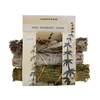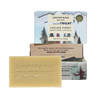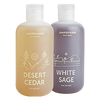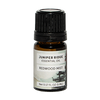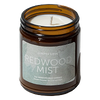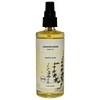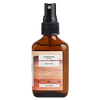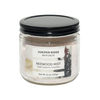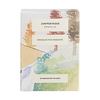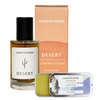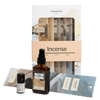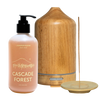
Can you talk about what led to you working with bees? How did you learn? Do you have a mentor or books that you value on the subject? My love for bees was sparked when I was WWOOF’ing on a farm in France. The farm I was living on had a few hives on their property to pollinate their orchard. The beekeeper did not speak English, and my French was limited, so I would silently watch him while he worked. I immediately became fascinated, and I had so many questions. I asked my mom to send me some books about beekeeping so that I could start to learn more. The books were the Practical Beekeeper and Natural Beekeeping; both books teach natural beekeeping, without chemicals and minimal intervention. When I got back to states, I drove from Chicago (where I was living at the time) to Wisconson, bought two hives, and been beekeeping ever since.
What do you love most about keeping bees? What’s the most difficult aspect? The thing that made me fall in love with beekeeping was one of the first times I went in my new hive. I opened the hive to an entirely self-sustaining society, that would exist with or without me. It was an incredibly grounding experience to see the bees, selflessly working together to grow and protect the colony. Every time I open the hive, I am reminded how small I am in the world, and it is a humbling experience. I would say the most challenging aspect is trying no to worry about the bees too much. If I see signs a hive is not doing well, whether the colony lost a queen, they swarmed, or varroa mites are taking over, I do all I can to help, but it is hard not to worry, I feel like they are my babies. Since I do everything organically, it means that I have to spend a lot more time monitoring the hives and treating with organic methods. I take all the necessary steps to keep my hives healthy, but at the end of the day, I have to trust that the bees are going to do their own thing, and I am here just to provide assistance when they need it.
What does a typical day look like in the life of a beekeeper? How interactive are you with them on the daily? I currently have ten hives in my backyard, so I don’t need to do maintenance every day, but I do interact with them daily. In the mornings I like to visit the hives and watch them fly in and out of the hive to forage for nectar, pollen, and water and make sure very hive is active. If I see a hive that is not active or on the opposite spectrum, a hive that is overflowing with bees, that is a good indication that I might need to check on them. On an average week, I go in the hives two or three times, and the activities can range on the season. My primary focus when I go in a hive is to make sure I have a healthy colony and a productive queen. There is always something that needs to be done in the hive though, and a successful beekeeper is one that is attentive and follows the clues that the bees are telling you in order to help them thrive.
Can you describe the seasons of the honey bee? Does your engagement with them wax and wane with the seasons? Each season is different. The season starts when it starts getting warm, usually around February in the Bay Area. I go in and inspect the hives to make sure they have survived through the winter and make sure they have enough bees and enough food to get them going in the spring. It usually takes a few months for them to start to build back their numbers from loosing the colony in winter. Then pretty much all throughout spring and summer, I am monitoring the colonies to make sure they have enough space to grow, harvesting honey and measuring the Varroa mite count. When the hives start to build up, I need to move fast to keep adding boxes to give them more space or else they will swarm. Then in the fall, I start to prepare them for the winter, so I leave them with at least 8-10 frames of honey and reduce the boxes to give them less space to keep warm in the cooler months. Then in the winter I leave them alone and hope for the best. If they have a healthy colony and enough food, then they are more likely to survive.
Can you talk a little about “bee culture?” What are the different bees in a hive and what rolls do they play? So each hive has one queen, and most of the hive is made up of worker bees who do all of the work in the hive, all worker bees are female. Each hive also has a small percentage of drones (the male bees) who don’t really do anything in the hive beside eat up honey, take up space, and wait for the chance to mate with a queen. The worker bee has a number of different tasks that she performs in her lifetime, and each task is based on their biological clock or how old they are. For example, when a bee emerges, for the first 1 to 3 days, she will clean out the cells to make sure they are ready for the queen to lay eggs or store nectar and pollen. Then from day 3 to 16 she moves to the undertaker role, which means she will remove any dead or diseased bees from the hive. Some of the other tasks are feeding the larva, taking care of the queen, guarding the hive, building honeycomb, and finally, once they are around 22 days old, they graduate to foraging, which they will do until they die.
Besides making honey, bees are critical to ecological health because of their roles as pollinators. Can you talk a little about that? Very true, bees are one of the best pollinators. You probably have heard that crazy fact that bees are responsible for one out of every three bites of your food. Well, it is true. Pollinators ensure production of seeds for plant reproduction and for producing fruits, nuts, and vegetable. Pollen is the honey bees source of protein, and they use it to feed their larva. As they are collecting pollen from flowers, they pass along pollen to other plants, specifical pollen from the male part of a flower to the female part of the flower, which fertilizes the plant. Bees are super pollinators because in one day a single bee can travel to hundreds of flowers and the bee is like a little fuzzy magnet for pollen. I love watching them collect pollen and nectar and seeing all of the different colored pollen they bring back to the hive.
Is the decline in bee colonies in America and Europe (CCD-Colony Collapse Disorder) a cause for concern? What do you attribute this decline to? Okay, this is a long answer, so apologies in advance! In my option, there are several reasons colonies are collapsing so rapidly. It is not one thing alone but the combination of tall three of the following things that are reducing the honey bee and native bee population. The first thing I attribute the decline of honey bees to is the modern practices that many industrial beekeepers have. They give the bees antibiotics, treat with miticides and feed them sugar syrup. These treatments do not allow the bees to built up a tolerance to the diseases and pests, which overall reduces their ability to fight back naturally. It is the same thing with us over using antibiotics. If every time you got a cold, you took antibiotic, then you would no longer be able to fight off the cold naturally and would need antibiotics to recover from a cold that your body should be able to fight. Well, the same thing is happening with bees. The second thing is the systemic pesticides and insecticides. Yes, on a large scale level with spraying crops, but also on a local level, where people spray roundup on their weeds in their front yard. A lot of times the bees don’t die right away. But it is the next generation of bees that is affected. The bees visit the plants that have been treated and go back to the colony and feed the infected pollen to the larva. The larvae hatch with a weakened immune system, and they do not live as long, which affects the hives ability to grow and sustain itself. The other cause of colony collapse are varroa mites. Pretty much every hive has varroa mites, and if a beekeeper doesnt do anything to prevent varroa mites in the hive, the varroa mites will kill the hive by spread diseases and reducing the lifespan of the bees. Okay, taking a step back, vorroa mites are these little mites that attach onto the back of the bee and feed on their blood. The mites reproduce in the hive by crawling into the comb with the larva and when the cell is capped the young mites feed off of the larva as it matures. When the bee emerges, so do all of the mites, and usually, the bee lives a shortened life. The problem is that many beekeepers are treating for varroa mites with these synthetic or even naturally derived chemicals. But the vorra mites will come back even after treatments, and the bees are not able to fight them off themselves. The way we can really help the bee population is to stop using so many unnatural treatments in the hive and through selective genetic breeding, have bees that are more resistant to mites. Obviously, it is much bigger than just that, but we need to start somewhere.
What’s the difference from purchasing honey from a small scale, local honey producer vs a larger commercial one? The main difference is that local beekeepers are able to practice organic beekeeping. Most commercial beekeepers are pollinating crops, and usually, have hundreds of hives to take care of, so in order to keep their bees alive they feed them antibiotics and treat for varroa mites with chemicals. Since they have so many hives, they can’t afford to spend the additional time it takes to do everything naturally. Not to mention most of the crops the bees pollinate are sprayed with pesticides, which the bees bring back to the hive. A local beekeeper or a beekeeper with a smaller production has more time to do things naturally and generally has better practices. But that is not the case for every beekeeper, which is why it is nice to know your beekeeper.
What can the average person do to encourage a healthy bee population? What kinds of plants do bees prefer? We need more beekeepers! If we had more backyard beekeepers that were using natural methods to keep bees, we would not need as many industrial beekeepers. But short of getting a hive; you can stop using any pesticides or insecticides in your backyard. Plant a garden with lots of native plants and pollen heavy flowers such as sages, mints, borage, yarrow, lavender, calendula, and ceanothus. It is also not a bad idea to have plants that bloom throughout the year to give them a steady food source. Every flower planted helps!
Do you feel afraid of them? Have you been stung? I am not afraid of bees anymore. When I first started, I was more cautious, but then I quickly learned to read the bees behavior and understand the signs if they were getting defensive. I have been stung before; it is just a part of being a beekeeper. In the beginning, I wouldn’t wear any protective gear, but after being stung in my face and having my whole face blow up, I decided it was a good idea to start wearing protective gear. I do not get stung that often, I would say around 5-10 times a year is pretty average. I have to be more careful not to get stung now though since I have developed an allergy to bee venom. A few months ago I got stung on my hand, and I had an intense response to the sting. After visiting an allergist, I found out I had developed an allergy to bee venom. Apparently, it is not uncommon for beekeepers to develop allergies to bee venom, sometimes it can be years before an allergy develops. So now I have to keep an epi-pen on me and make sure I wear layers and extra protective gear to prevent from getting stung.
What’s your personal favorite way to consume honey? I love cooking with honey! I use honey for tea on a regular basis, but I like using the honey in place of refined sugar. I use it to make salad dressings, mix honey with Dijon mustard for a salmon rub, using it as a substitute for refined sugar in recipes. A favorite at parties is cheese and honey; you can never go wrong with a freshly baked baguette, some brie and a big gob of honey on top.


